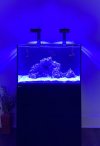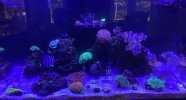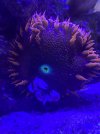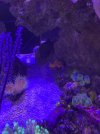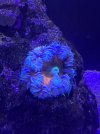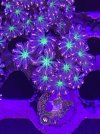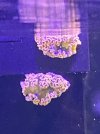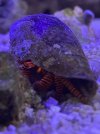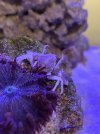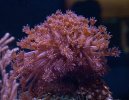We started the build with Moani dry rock, live sand, two lights, skimmer, heater, return pump and the stock gravity fed ATO. Cycling took 4 months, learning so much along the way. Bacteria in a bottle was our friend, but it took a while to find the right one! First Seed for 1.5 months, then Microbacter7 for another 1.5 months. Dosed ammonia with no success, until I found refrigerated Dr Tim’s All in One. We were cycled in one week after that! I hear Biospira is a good one too for all those newbies.
Ready for our first fish, Gladiator Clownfish pair Cat and Sam were purchased! Very sweet and already mated, Cat became the female with time. They host the back wall of the tank!

. Some basic CUC of hermits and snails were added to start stirring the sand bed. We picked up our first of the wavemaker pair, a Red Sea gyre.
To keep the family under control, we had a two week rule, only adding a new fish every two weeks once we knew the prior crew was settled. It balanced the tank bioload and kept us from impulse purchasing.
My daughter wanted an eel, so she settled on an engineer goby. He dug so many sand caves and it was enjoyable to watch him grow. Sadly, he jumped a few weeks ago, folllowing some tang bullying.
Next two weeks, we opted for an algae eater, our dear starry blenny named Nebby, a space themed Nebulus homage courtesy of my son. Our first corals came home that day too, a favia, lepestrea, and bowerbanki. A trip to a fellow member scored me my first hammer too!
During my research of corals and fish, I fell in love with the Fiji leather coral and birthday splurged on myself to pick up that beauty when I found it in stock. Still one of my favorites! My husband impulse purchased a tiny yellow clown goby, but he never quite settled into my big tank. I’d save him for nano tanks in the future, where you could keep a good eye out!
Next pair of fish were on my husbands wish list, and I was nearing the total fish count for the tank. These two tangs were inseparable for a long time, the Sailfin and baby yellow tang that followed big brother like a toddler. I didn’t want both, but couldn’t leave that gorgeous baby behind. And here I thought we were done!
Weeks later, my son fell for a long nose pygmy hawk fish, but he only lived a few months before he got spooked and jumped one sad night.
All was good for many months, working through the tank uglies and trying 3 day black outs to get things under control. I picked up a coral banded shrimp to hunt bristleworms in the display and an arrow crab in the sump refugium. The shrimp is still running strong, walking around like the hulk. I sadly waited too long to give away my bristleworm eating arrow crab, he was such a good eater and fed regularly. He died unexpectedly while I was out of town, still not sure what happened.
One night of observations revealed tiny snail like creatures on the glass. I researched like crazy and decided they weren’t snails, but flatworms! So off to find my last fish, a melanarus wrasse. Excellent final fish addition and quite efficient at keeping the flatworms away!

